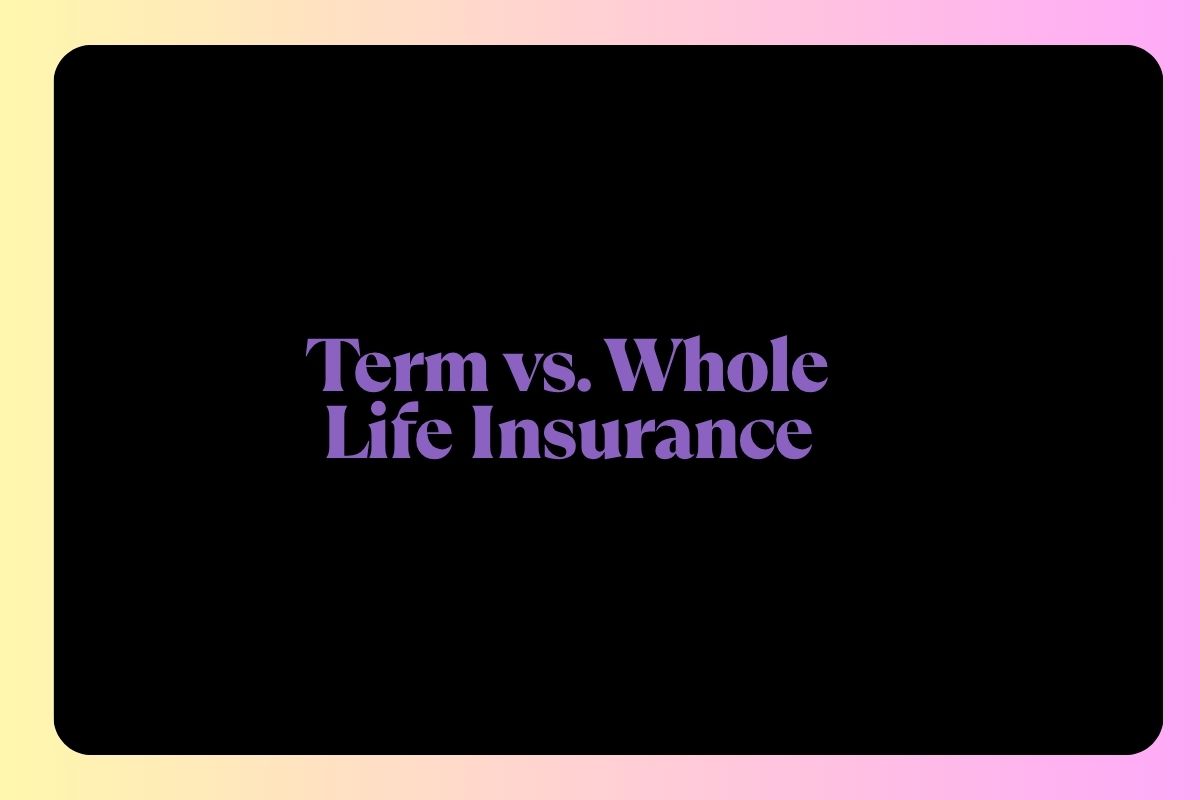When it comes to securing your family’s financial future, life insurance is a must. But with so many options available, understanding which policy is right for you can feel overwhelming. The two most popular types—term life insurance and whole life insurance—offer different benefits, costs, and features.
In this comprehensive 2025 guide, we’ll break down term vs. whole life insurance, explain how each works, compare costs, and help you determine the best fit for your unique needs and long-term financial goals.
What Is Term Life Insurance?
Term life insurance provides coverage for a specific period—typically 10, 20, or 30 years. If you pass away during the policy term, your beneficiaries receive the death benefit. If you outlive the term, the policy expires, and there’s no payout (unless you choose a return-of-premium rider).
✅ Key Features:
-
Affordable premiums
-
Fixed term coverage
-
No cash value
-
Simple structure
👍 Best For:
-
Young families
-
Budget-conscious individuals
-
People with temporary financial obligations (like a mortgage or raising kids)
What Is Whole Life Insurance?
Whole life insurance, also known as permanent life insurance, provides lifelong coverage as long as premiums are paid. In addition to the death benefit, it includes a cash value component that grows over time and can be borrowed against or withdrawn.
✅ Key Features:
-
Lifetime protection
-
Builds cash value
-
Level premiums
-
Option to earn dividends (with participating policies)
👍 Best For:
-
Long-term financial planning
-
Estate planning
-
High-net-worth individuals
-
Those wanting a savings component
Term vs. Whole Life Insurance: Side-by-Side Comparison
| Feature | Term Life Insurance | Whole Life Insurance |
|---|---|---|
| Duration | 10–30 years | Lifetime |
| Premiums | Lower | Higher |
| Cash Value | No | Yes |
| Flexibility | Limited | Offers more financial tools |
| Investment Component | None | Yes, guaranteed cash growth |
| Policy Cost Over Time | Cost-effective short term | More costly but lifelong |
| Ideal For | Temporary coverage | Permanent protection and wealth building |
Cost Comparison in 2025
One of the most significant differences between term and whole life insurance is cost.
Example:
For a healthy 30-year-old non-smoker:
-
20-Year Term Policy ($500,000): ~$20–$30/month
-
Whole Life Policy ($500,000): ~$200–$400/month
The difference is due to the guaranteed lifelong coverage and the cash value accumulation in whole life policies. While term insurance is much cheaper, it doesn’t offer any savings or investment features.
How to Choose the Right Life Insurance for You
Choosing between term and whole life insurance depends on your financial goals, life stage, and budget.
✔️ Choose Term Life Insurance If:
-
You want affordable protection.
-
You only need coverage for a set period (e.g., until your kids graduate or mortgage is paid).
-
You prefer to invest your savings separately (e.g., through a 401(k) or mutual funds).
✔️ Choose Whole Life Insurance If:
-
You want lifelong financial protection.
-
You’re looking for a forced savings plan with tax-deferred growth.
-
You have estate planning needs.
-
You want a guaranteed cash value to borrow from later in life.
Trends in Life Insurance in 2025
Life insurance has evolved in the digital age. In 2025, here’s what you can expect:
🔹 No-Medical-Exam Policies
More insurers now offer simplified issue and accelerated underwriting, making it easier to get term or whole life insurance without a physical exam.
🔹 AI-Based Risk Assessment
Advanced technology helps insurers assess risk quickly, allowing for faster approvals and more personalized premium rates.
🔹 Hybrid Policies
Some life insurance products now combine life coverage with long-term care or critical illness benefits—adding more flexibility and value.
Pros and Cons Summary
Term Life Insurance:
Pros:
-
Affordable premiums
-
Easy to understand
-
Good for temporary needs
Cons:
-
No cash value
-
Coverage ends with term
-
Renewal after term can be costly
Whole Life Insurance:
Pros:
-
Lifelong coverage
-
Builds cash value
-
Can be part of estate or retirement planning
Cons:
-
High premiums
-
Complex structure
-
Cash value growth is slow in early years
What Happens If You Stop Paying Premiums?
For Term Life:
-
Policy lapses.
-
You lose coverage and no refund unless you have a return-of-premium rider.
For Whole Life:
-
Policy may stay active using cash value to pay premiums.
-
You can surrender the policy for its cash value, though surrender charges may apply.
check instagram bio on socialxbio.com
Should You Convert Your Term Policy to Whole Life?
Many term policies offer a conversion option—letting you switch to a permanent policy without a medical exam. This is ideal if:
-
Your health declines and you want permanent coverage.
-
You want to start building cash value.
-
You now have more income to afford lifelong insurance.
Always check your conversion deadline—usually within the first 10 years of the term.
Final Thoughts
When deciding between term and whole life insurance, there’s no one-size-fits-all answer. Term life is perfect for those looking for affordable, temporary protection, while whole life suits those who want lifelong coverage and a savings component.
The best strategy? Evaluate your financial situation, goals, and responsibilities. You may even consider combining both—start with term life and convert to whole life when your budget allows.



